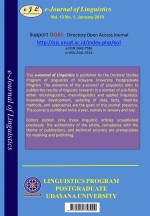Local Marriage System of Boti Community Depicted Through its Speech Ritual
Abstract
Marriage system in the indigenous trust describes the relationship of supernatural effect on family kinship in the community. Such the relevance is the primary identifier and the identity of the diversity of the Indonesian nation. It is inevitable that a cultureas a pillar of diversity is a buffer for entering the era of multicultural and globalization. Values of Humanist ??is the power of social relation among individuals in the community groups. This paper describes the characteristic of marriage in society of Boti in East Nusa Tenggara who hold the original trust Halaika.The results shows behaviors that indicate homage to supernatural of Uis Pah (Ruler of the Earth), Uis Oe (Ruler of Water) and Uis Neno (Ruler of Heaven) in a series of marriages that is rich of value and meaning.
Downloads
References
De Saussure, Ferdinand. 1993. Pengantar Linguistik Umum.Terjemahan buku Course de Linguistique Generale, oleh Kridalaksana, Harimurti. Yogyakarta: Gajah Mada University Press.
Dhavamony, Mariasusai. 1995. Fenomenologi Agama. Terjemahan buku Phenomenology of Religion. Yogyakarta: Kanisius.
Duranti.Alesandro. 1985. Sociocultural Dimension of Discourse. Dalam Handbook of Discourse Analisys, Vol. 1.Academic Press
Duranti.Alesandro. 1997. Linguistic Anthropology. Cambridge: Cambridge University Press.
Eco, Umberto. 1984. Semiotics and the Philosophy of Language. Basingstoke: Macmillan.
Eco, Umberto. 2009. Teori Semiotika. Diterjemahkan dar iA Theory Of Semiotics oleh Inyiak Ridwan Muzir. Yogyakarta: KreasiWacana.
El-Aswald, El-Sayed. 2002. Religion and Folk Cosmology: Scenario of the Visible and Invisible in Rural. London: Greenwood.
Eriyanto. 2005. Analisis Wacana: Pengantar Analisis Teks Media. Yogyakarta: LKiS.
Errington, Joseph. 1982. Speech in The Royal Presence: Javanese Palace Language, dalammajalah Souteast Asia Program, Volume 34.
Evans, Vyvyan, dkk. 2010. The Cognitive Linguistics Enterprise: an overview.
Faisal, Sanapiah. 1990. Penelitiah Kualitatif: Dasar-dasar dan Aplikasi. Malang: YayasanAsah, Asih, Asuh
Flick, Uwe. 2004. Triangulation in Qualitative Research. Dalam A Companion to Qualitative Research.London: Sage.
Foley, William A. 1997. Anthropological Linguistics: An Introduction. USA: Blackwell
Fox, James. 1986. Bahasa, Sastra, dan Sejarah; Kumpulan Karangan Masyarakat Pulau Roti. ILDEP.
Fox, James. 2006. Memories of Ridges-Poles and Cross-Beames: The Categorical Foundations of a Rotinese Cultural Design, dalam Fox, James J. (ed), Inside Austronesian Hauses: Perspective on Domestic and Disigns for Living. Cambera: ANU
Gallagher, Shaun dan Dan Zahavi. 2008. The Phenomenological Mind: An Introduction to Philosophy of Mind and Cognitive Science. London:Routledge.
Rumung, Wens John. 1998. Misteri Kehidupan Suku Boti. Kupang: YayasanBoti Indonesia.
Sharifian, Farzad. 2011. Cultural Conceptualisations and Language: Theoretical Framework and Applications. Amsterdam: John Benjamins Publishing Company
Sibarani, Robert. 2004. Antropolinguistik. Medan: Poda.
Soames, Scott. 2010. Philosophy of Language. UK: Princeton University Press.
Spinelli, Ernesto. 2005. The Interpreted World: An Introduction to Phenomenological Psychology. London: SAGE.
Widiyatmika, Munandjar. 2008. Kebudayaan Masyarakat di Bumi Cendana.Kupang: Pusat Pengembangan Madrasah.

This work is licensed under a Creative Commons Attribution 4.0 International License.

This work is licensed under a Creative Commons Attribution 4.0 International License











